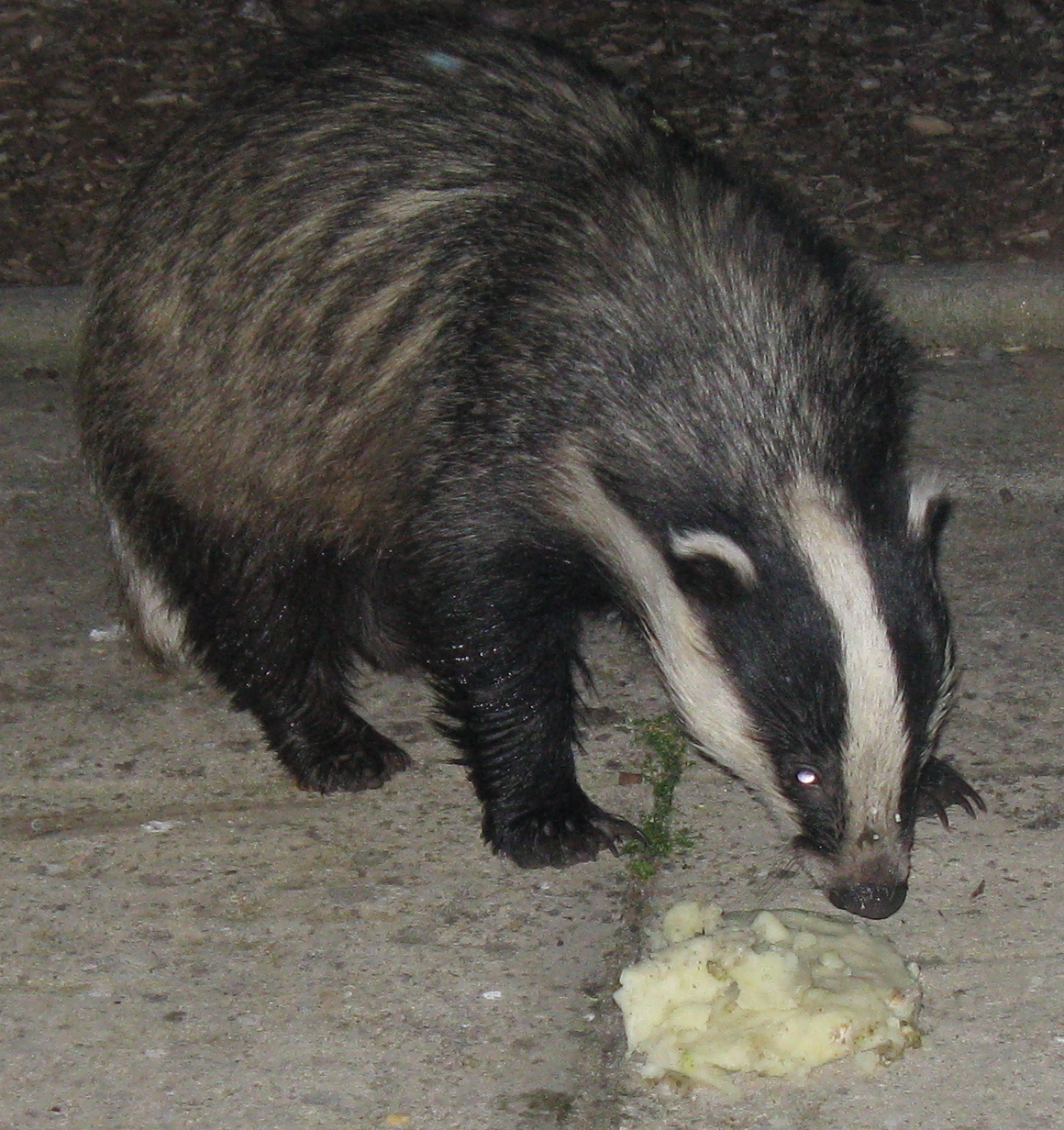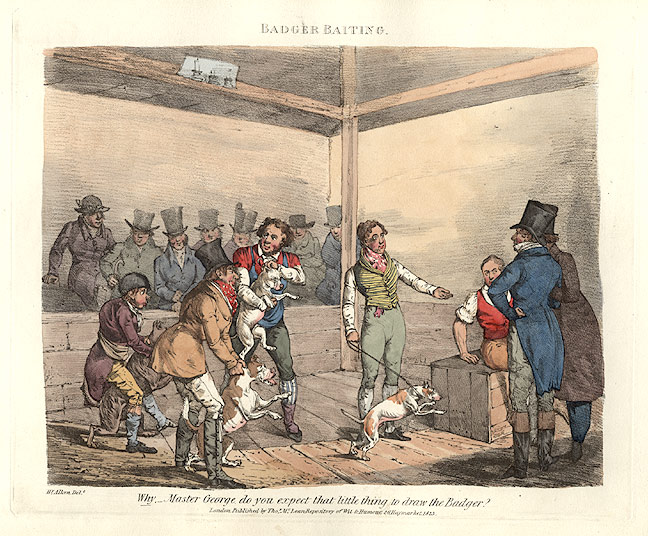|
European Badger
The European badger (''Meles meles''), also known as the Eurasian badger, is a badger species in the family Mustelidae native to almost all of Europe. It is classified as least concern on the IUCN Red List as it has a wide range and a large stable population size, and is thought to be increasing in some regions. Several subspecies are recognized with the nominate subspecies (''M. m. meles'') predominating in most of Europe. In Europe, where no other badger species commonly occurs, it is generally just called the "badger". The European badger is a powerfully built, black, white, brown, and grey animal with a small head, a stocky body, small, black eyes, and short tail. Its weight varies, being 7–13 kg (15–29 lb) in spring, but building up to 15–17 kg (33–37 lb) in autumn before the winter sleep period. It is nocturnal and is a social, burrowing animal that sleeps during the day in one of several setts in its territorial range. These burrows have multipl ... [...More Info...] [...Related Items...] OR: [Wikipedia] [Google] [Baidu] |
Middle Pleistocene
The Chibanian, widely known by its previous designation of Middle Pleistocene, is an Age (geology), age in the international geologic timescale or a Stage (stratigraphy), stage in chronostratigraphy, being a division of the Pleistocene Epoch within the ongoing Quaternary Period. The Chibanian name was officially ratified in January 2020. It is currently estimated to span the time between 0.770 annum, Ma (770,000 years ago) and 0.126 Ma (126,000 years ago), also expressed as 770–126 ka. It includes the transition in palaeoanthropology from the Lower Palaeolithic, Lower to the Middle Palaeolithic over 300 ka. The Chibanian is preceded by the Calabrian (stage), Calabrian and succeeded by the proposed Tarantian. The beginning of the Chibanian is the Brunhes–Matuyama reversal, when the Earth's magnetic field last underwent reversal. It ends with the onset of the Eemian interglacial period (Marine Isotope Stage 5). The term Middle Pleistocene was in use as a provisional or "quasi-fo ... [...More Info...] [...Related Items...] OR: [Wikipedia] [Google] [Baidu] |
Earthworm
An earthworm is a terrestrial invertebrate that belongs to the phylum Annelida. They exhibit a tube-within-a-tube body plan; they are externally segmented with corresponding internal segmentation; and they usually have setae on all segments. They occur worldwide where soil, water, and temperature allow. Earthworms are commonly found in soil, eating a wide variety of organic matter. This organic matter includes plant matter, living protozoa, rotifers, nematodes, bacteria, fungi, and other microorganisms. An earthworm's digestive system runs the length of its body. An earthworm respires (breathes) through its skin. It has a double transport system made of coelomic fluid that moves within the fluid-filled coelom and a simple, closed circulatory system. It has a central and peripheral nervous system. Its central nervous system consists of two ganglia above the mouth, one on either side, connected to a nerve running along its length to motor neurons and sensory cells in e ... [...More Info...] [...Related Items...] OR: [Wikipedia] [Google] [Baidu] |
Oxford English Dictionary
The ''Oxford English Dictionary'' (''OED'') is the first and foundational historical dictionary of the English language, published by Oxford University Press (OUP). It traces the historical development of the English language, providing a comprehensive resource to scholars and academic researchers, as well as describing usage in its many variations throughout the world. Work began on the dictionary in 1857, but it was only in 1884 that it began to be published in unbound Serial (literature), fascicles as work continued on the project, under the name of ''A New English Dictionary on Historical Principles; Founded Mainly on the Materials Collected by The Philological Society''. In 1895, the title ''The Oxford English Dictionary'' was first used unofficially on the covers of the series, and in 1928 the full dictionary was republished in 10 bound volumes. In 1933, the title ''The Oxford English Dictionary'' fully replaced the former name in all occurrences in its reprinting as 12 ... [...More Info...] [...Related Items...] OR: [Wikipedia] [Google] [Baidu] |
Derivation (linguistics)
Morphological derivation, in linguistics, is the process of forming a new word from an existing word, often by adding a prefix or suffix, such as For example, ''unhappy'' and ''happiness'' derive from the root word ''happy.'' It is differentiated from inflection, which is the modification of a word to form different grammatical categories without changing its core meaning: ''determines'', ''determining'', and ''determined'' are from the root ''determine''. Derivational patterns Derivational morphology often involves the addition of a derivational suffix or other affix. Such an affix usually applies to words of one lexical category (part of speech) and changes them into words of another such category. For example, one effect of the English derivational suffix ''-ly'' is to change an adjective into an adverb (''slow'' → ''slowly''). Here are examples of English derivational patterns and their suffixes: * adjective-to-noun: ''-ness'' (''slow'' → ''slowness'') * adjecti ... [...More Info...] [...Related Items...] OR: [Wikipedia] [Google] [Baidu] |
Bovine Tuberculosis
Bovines ( subfamily Bovinae) comprise a diverse group of 10 genera of medium to large-sized ungulates, including cattle, bison, African buffalo, water buffalos, and the four-horned and spiral-horned antelopes. The evolutionary relationship between the members of the group is still debated, and their classification into loose tribes rather than formal subgroups reflects this uncertainty. General characteristics include cloven hooves and usually at least one of the sexes of a species having true horns. The largest extant bovine is the gaur. In many countries, bovid milk and meat is used as food by humans. Cattle are kept as livestock almost everywhere except in parts of India and Nepal, where they are considered sacred by most Hindus. Bovids are used as draft animals and as riding animals. Small breeds of domestic bovid, such as the Miniature Zebu, are kept as pets. Bovid leather is durable and flexible and is used to produce a wide range of goods including clothing and bags. ... [...More Info...] [...Related Items...] OR: [Wikipedia] [Google] [Baidu] |
|


